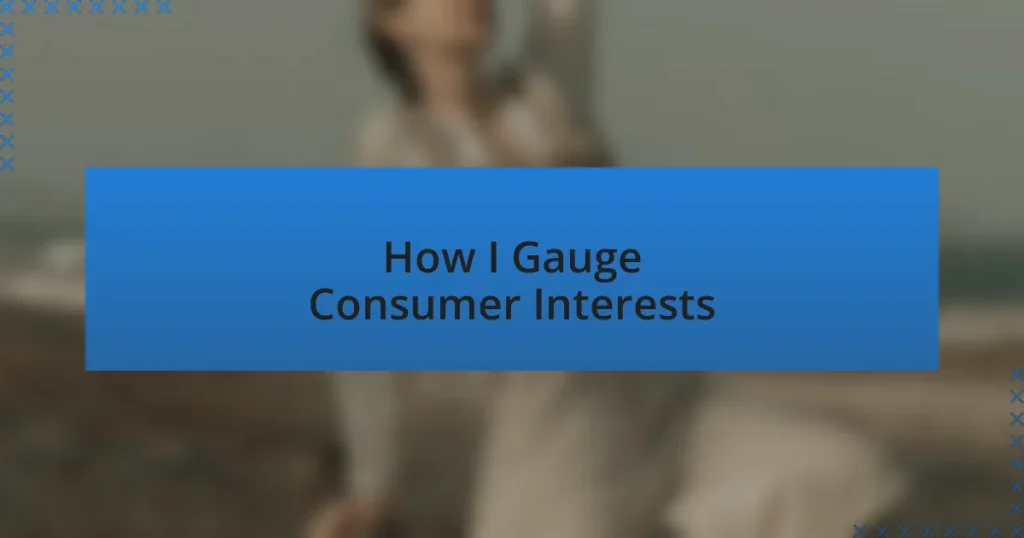Key takeaways:
- Understanding consumer interests involves tapping into emotional connections and community engagement rather than just data.
- Direct audience engagement through Q&As and polls uncovers valuable insights that shape relevant content and foster connections.
- Adapting content based on consumer feedback enhances reader satisfaction and cultivates a loyal following.
- Sharing personal experiences creates relatable narratives that deepen connections with readers, transforming the blog into a supportive community.
Author: Charlotte Hawthorne
Bio: Charlotte Hawthorne is an acclaimed author known for her compelling storytelling and richly drawn characters. With a passion for exploring the complexities of human relationships, her novels often blend elements of romance, intrigue, and self-discovery. A graduate of the University of California, Charlotte has received multiple awards for her work, including the prestigious Silver Quill Award. When she’s not writing, she enjoys hiking in the Sierra Nevada mountains and sipping coffee at local cafes. Charlotte currently resides in San Francisco with her rescue dog, Jasper.
Understanding consumer interests
Understanding consumer interests is all about tapping into the evolving psyche of your audience. I remember when I first started blogging about fashion; I was surprised to find that many of my readers were more interested in sustainable practices than just the latest trends. Isn’t that fascinating? It reveals how lifestyle choices reflect deeper values.
As I dive deeper into this realm, I’ve noticed that seasonal changes often spark shifts in what consumers crave. For instance, come spring, there’s an unmistakable desire for color and renewal. I’ve learned to anticipate these trends and create content that resonates with those sentiments. Have you ever thought about what makes a trend feel so relevant at a particular time? It’s those emotional connections that keep readers engaged.
It’s crucial to listen actively through comments and social media interactions. One day, a reader shared how a post inspired her to revamp her wardrobe by focusing on pieces that spark joy rather than just following the latest fashions. This experience highlighted to me that understanding consumer interests isn’t just data-driven; it’s about fostering a sense of community and understanding the emotional lives of your readers.
Importance of gauging consumer interests
Gauging consumer interests is vital for tailoring content that truly resonates. I recall a time when I shifted my focus to vintage fashion after noticing a surge in interest within my community. This pivot not only sparked lively discussions but also generated enthusiastic feedback, proving that when you align your content with what your readers crave, you cultivate a loyal following.
Moreover, tapping into these interests can shape marketing strategies effectively. There was a moment when I shared a behind-the-scenes look at sustainable fashion brands, and it turned into one of my most shared posts. Have you ever wondered how a single post can create a ripple effect in engagement? It’s that connection to consumer interests that can extend your reach and influence.
Lastly, understanding your audience helps in predicting future trends. When I started receiving inquiries about layering techniques for cooler months, it became clear that my readers were looking for practical, seasonal advice. By tuning into these signals, I not only serve my audience better but also position myself as a trusted voice in the industry. Isn’t it rewarding to know you’re meeting real needs?
Tools for measuring consumer interests
When it comes to measuring consumer interests, analytics tools play a crucial role. I often rely on Google Analytics to track visitor behavior on my blog. For instance, when I noticed an uptick in page views on posts about eco-friendly fashion, it felt like a lightbulb moment—confirming that my audience was genuinely excited about sustainable options.
Another tool I find invaluable is social media listening platforms like Hootsuite or Sprout Social. These tools help me monitor trends and conversations around fashion topics in real time. I remember the thrill of discovering a trending hashtag related to a seasonal style revival; it felt like finding a treasure map, guiding my next content creation journey.
Don’t underestimate the power of surveys and polls as well. I once conducted a simple Instagram poll asking followers about their favorite fashion seasons. The feedback was overwhelmingly insightful, revealing unexpected preferences that shaped my upcoming content plan. Have you ever considered how directly asking your audience can uncover insights that data alone might miss? Engaging with them not only builds trust but also enriches your content.
Analyzing fashion trends and preferences
Understanding the nuances of fashion trends requires a keen eye and an analytical approach. I remember scanning Pinterest after noticing a spike in interest for oversized blazers. The visuals were captivating, and the engagement on my post about styling them skyrocketed. It was fascinating to see how a single garment could inspire a wave of creativity and enthusiasm in the fashion community.
I often dive into fashion shows and street style after significant events, as they provide a treasure trove of insights into emerging trends. One year, after the Paris Fashion Week, I was surprised to see an influx of interest in bold colors and prints. This led me to curate a special segment on vibrant styles on my blog, igniting a conversation that resonated deeply with my audience. Have you ever been inspired by something as fleeting as a runway moment?
Analyzing consumer preferences goes beyond just numbers; it taps into the emotions and experiences behind the choices. I once wrote a piece on nostalgic fashion trends that took me back to my childhood—suddenly, my readers were sharing their own stories, creating a beautiful dialogue about shared memories. This type of engagement not only helps shape content but creates a community where readers feel heard and valued.
Engaging with your audience directly
Engaging directly with your audience can be a game-changer in understanding their interests. I recall a time when I hosted a live Q&A session on Instagram, inviting my followers to share their fashion dilemmas. Not only did it provide immediate feedback on what styles to explore, but it also fostered a sense of connection. Isn’t it refreshing to know that your audience isn’t just numbers but real people with unique stories?
Another effective method I’ve found is utilizing polls on social media platforms. One day, I asked my followers which fashion trend they were most excited to try for the summer. The responses poured in, revealing insights that I hadn’t previously considered. It was enlightening to see how eager my readers were to voice their opinions, and it sparked new content ideas that directly aligned with their interests.
When I opened a discussion about sustainable fashion in my blog comments, I was touched by the depth of the conversations that unfolded. Readers shared their journeys toward more eco-friendly choices, and I felt privileged to witness this exchange. It made me realize how powerful direct engagement is—it transforms a simple fashion blog into a vibrant community where diverse voices come together. Don’t you think there’s something special about hearing stories that genuinely resonate with our own experiences?
Adapting content to consumer feedback
Adapting content to consumer feedback is vital in the ever-evolving fashion landscape. I remember a time when I wrote a piece on seasonal wardrobe staples, and the feedback was overwhelmingly clear—my readers craved more tips on budgeting for these essentials. This insight not only reshaped my approach but also led to a series focused on smart shopping techniques, directly responding to their needs. How rewarding is it to create content that resonates so deeply?
Another experience that stands out was when I initiated a survey to understand my audience’s favorite styling tips. Managing the results was eye-opening; the overwhelming interest in vintage fashion inspired me to launch a dedicated segment showcasing thrifted finds and creative pairing ideas. Adapting my content in this way felt like tuning into a shared wavelength with my readers. Wouldn’t you agree that aligning content with audience interests creates a more enjoyable reading experience?
It’s no secret that consumer feedback can guide your content in unexpected yet fulfilling directions. After incorporating reader suggestions into my blog, I witnessed a spike in engagement and even more heartfelt comments. Knowing that my audience felt heard and valued transformed my writing. Isn’t it fascinating how a simple change based on feedback can strengthen the bond with your readers?
Sharing personal experiences to connect
Sharing personal experiences is an effective way to cultivate a deeper connection with readers. One memorable moment for me was when I shared the story of my first fashion mishap at a party. I was so confident in my outfit until a small wardrobe malfunction turned my night upside down. Many readers reached out, sharing their own stories of fashion fails, and it brought us closer together. It’s incredible how vulnerability breeds connection, isn’t it?
When I decided to open up about my struggle with finding a personal style that feels authentic, I didn’t expect such an outpouring of support. Readers began to share their journeys, and this exchange transformed our online space into a supportive community. It felt like having a heart-to-heart with friends over coffee, discussing the ups and downs of finding oneself through fashion. Have you ever felt that instant bond over shared challenges?
I’ve also found that weaving personal stories into style advice fosters a relatable atmosphere. For instance, when I recounted how a thrifted blazer reminded me of my grandmother and her unique sense of style, readers responded with their own nostalgic tales. It opened the door to discussions that were much more than just fashion tips. Isn’t it delightful how a simple memory can evoke a shared experience, creating a meaningful dialogue?


